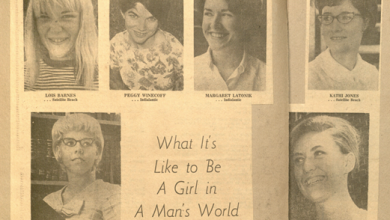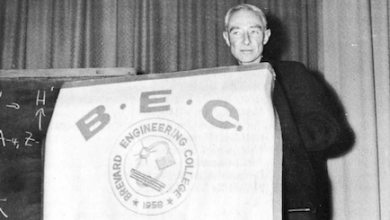Secret History: Radio Free Melbourne
Dateline: 1975/2022

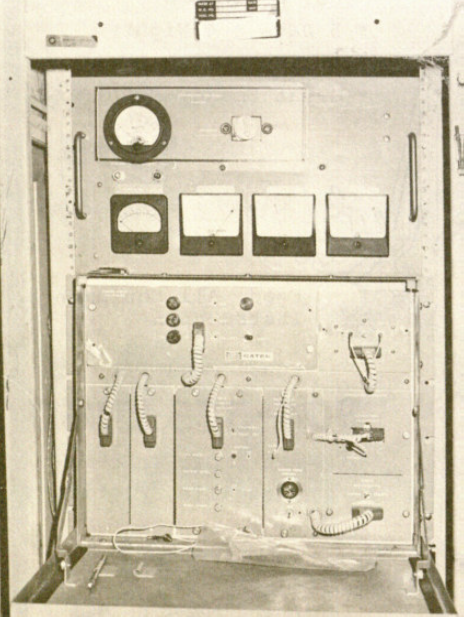
“This is the culmination of years of courage and effort on the part of the students,” Ray Work Jr., then Florida Tech’s dean of students, declared. “I think we’re going to make it this time.”
In 1968, the members of the Florida Tech Ham Radio Club began a campaign to establish a campus radio station. Four years later, Florida Tech applied to the Federal Communications Commission (FCC) for a license to operate a 10-watt transmitter. On September 29, 1973, the FCC notified Work the application was approved. The FCC gave Florida Tech permission to use a 10-watt educational, noncommercial radio station on the frequency of 91.5 megacycles.
“We’re trying to get the letters WFIT, but we aren’t sure we’ll get them,” Work told a Florida Today reporter. “You have to ask for five different sets in order of desire.”Palmer, P. (1973, December 25). F.I.T. Gets FM Radio Station Permit. Florida Today.
The Long and Winding Road
The FCC’s go-ahead opened a host of challenges.
In February, the FCC assigned the station the call sign “WFIT.” Construction began in fall 1974. The station was to be housed in dorm rooms on the first floor of Roberts Hall. In the beginning, WFIT was a student-run organization.
“If enthusiasm was convertible to cash, the handful of Florida Tech students working on the station would be flush,” Ed Meadows wrote. “But, in fact, the student volunteers have to depend on donations and free help for construction of WFIT.”Meadows, E. (1974, May 17). WFIT to Make Air Waves. Florida Today.
Firefighters from Melbourne Fire Department raised the station’s antenna on the roof of Roberts Hall. A Fort Lauderdale company supplied four turntables. A Satellite Beach resident donated a transmitter and another turntable. An engineer from Miami provided two cartridge tape machines.
Gary Bowie, a 20-year-old marine biology student from Red Bank, New Jersey, was WFIT’s first general manager.
“I work well under pressure,” Bowie said. “I just can’t sit idle. I’ve got to be doing something all the time.”Cleveland, W. (1975, n.d.). Bowie is Cutting His Way in Broadcasting Field. Melbourne Times.
Bowie joined the campaign to launch WFIT during his freshman year. Funding the entirely student-run organization and finding volunteers to serve as DJ kept Bowie busy in the weeks leading to WFIT’s going on the air.
“I think people will help us,” said Greg Adragna, who served as the assistant program director. “When one man heard we could have classical music, he said he would be glad to donate some money. A girl at the campus cafeteria gave us five dollars.”Meadows, E. (1974, May 17). WFIT to Make Air Waves. Florida Today.
WFIT’s first broadcast was scheduled for April 1, 1975. The FCC, however, played an April Fool’s joke: A clerk in Washington mistakenly did not forward the station’s license. On Friday, April 4, the FCC sent a telegram approving the station’s going on air.
At 7 p.m., DJ Charlie Brown announced, “This is WFIT 91.5 in Melbourne, Florida.”
On the Air
“We started out,” Jeff Fleming, a junior air commerce major and the station’s programming manager, told a reporter, with “a song called ‘Hard Headed Woman’ by Cat Stevens.”Melbourne’s New Station Airs its First Broadcast. (1975, April 5). Florida Today.
Initially, WFIT was on the air from 7 p.m. to 1 a.m. Fleming, who replaced Bowie as the station’s general manager, planned to begin each evening with 90 minutes of classical music, followed by a mystery serial and progressive-rock music.

Within weeks of going on the air, Fleming and his comrades at WFIT found themselves in a controversy. In May 1975, a group of 300 students gathered in front of the president’s office protesting the administration’s policies.
“Tomorrow, if they don’t come to us,” Dale Thomson shouted, “we go to them.”
The students’ complaints included planned increases in tuition, mismanagement of work-study jobs and the charge that “Florida Tech has censored the school’s F.M. radio station, WFIT.”
University president Jerome P. Keuper acknowledged that he had failed in his communications with students. He promised that he would work to do better in the future.Dart, B. (1975b, May 13). Students Peacefully Protest F.I.T. Administration Policy. Florida Today.
The protest proved to be a good-natured affair. A Florida Today reporter noted that Florida Tech students represented a “new generation of university protestors.” They had a sense of humor. It was more like an episode out of a “Doonesberry” cartoon than a militant rally at UCLA.
“Maybe,” one student said, “it’s the end to student apathy.” A surfer agreed, calling for a protest of the lack of good waves.Dart, B. (1975a, May 13). F.I.T. Protest Only a Shade of Militant Rioting of 1960s. Florida Today.
“Pulling the Plug”
The issue of censorship remained unresolved. Two years later, in 1977, Work, then the vice president of administration, pulled the plug on the Iranian Student Association’s weekly broadcast.
About 20 to 30 Iranian Florida Tech students had traveled to Washington to participate in a massive protest of the shah of Iran’s meeting with president Jimmy Carter. One feature of the 30-minute program broadcast in English and Farsi was “reading news about Iran published in several newspapers, including Florida Today.”
Apparently, this was what caught the administration’s attention. Work, who acknowledged he had not personally listened to the broadcasts, said the Iranian students’ charge of censorship was “nonsense.” He claimed that WFIT’s FCC license prohibited political or commercial programming. Work declared that he had acted to protect the station.F.I.T. Officials Pull Plug on Iranian Student Radio Program. (1977, November 29). Florida Today.
The Iranian incident exposed an underlying problem in the relationship between the student-run station and the university’s administration. In its first years, the station’s 10-watt transmitter meant that the station reached only a few listeners.
In 1979, the FCC authorized WFIT’s application to boost its power to 3,000 watts. The FCC assigned the station a new frequency, 89.5 megacycles, to prevent interference with nearby stations. The station’s record library had grown to more than 4,000 albums.Watts for WFIT. (1979, November 1). The Crimson.

By 1980, 89.5’s signal was on the air 24/7. The new transmitter meant that the station reached an audience in a 35-mile radius from Roberts Hall.
A year later, Barry Fullerton, then vice president for student affairs, announced that students would no longer elect WFIT’s general manager. Citing unspecified “certain incidents” as justification, Fullerton said, “the station was no longer classified as a student organization.” He claimed that the changes would allow WFIT “to realize its potential to become the leading radio station in Brevard County.”WFIT: Drastic Changes. (1981, April 20). The Crimson.

WFIT’s Barbecue
Significant changes came in the next decade.
In 1982, WFIT’s student general manager, Cliff Lethbridge, launched the station’s first effort at local programming with a “hoot and holler … off the cuff program” called “R.G.’s Barbecue.”
A dozen men and women gathered in the cramped Roberts Hall studio to broadcast a potpourri of music, jokes and stories. Robert “Bob” Goldberg, R.G., narrated the program, which included discussions of barbecue recipes, local fishing tips and tall tales. “R.G.’s Barbecue” was WFIT’s answer to Garrison Keillor’s “Prairie Home Companion,” which aired in 1974 on Minnesota Public Radio.Hellmich, N. (1982, May 10). WFIT offers listeners a musical ‘barbecue”. Florida Today.
Some old WFIT standbys continued for a time under the new regime. Keuper hosted a luncheon in honor of Sonny Marble’s 500th “Music at Dusk” broadcast. Marble, a Brooklyn Conservatory of Music graduate and Harris Semiconductor employee, began “spreading the gospel” of classical music in 1975.
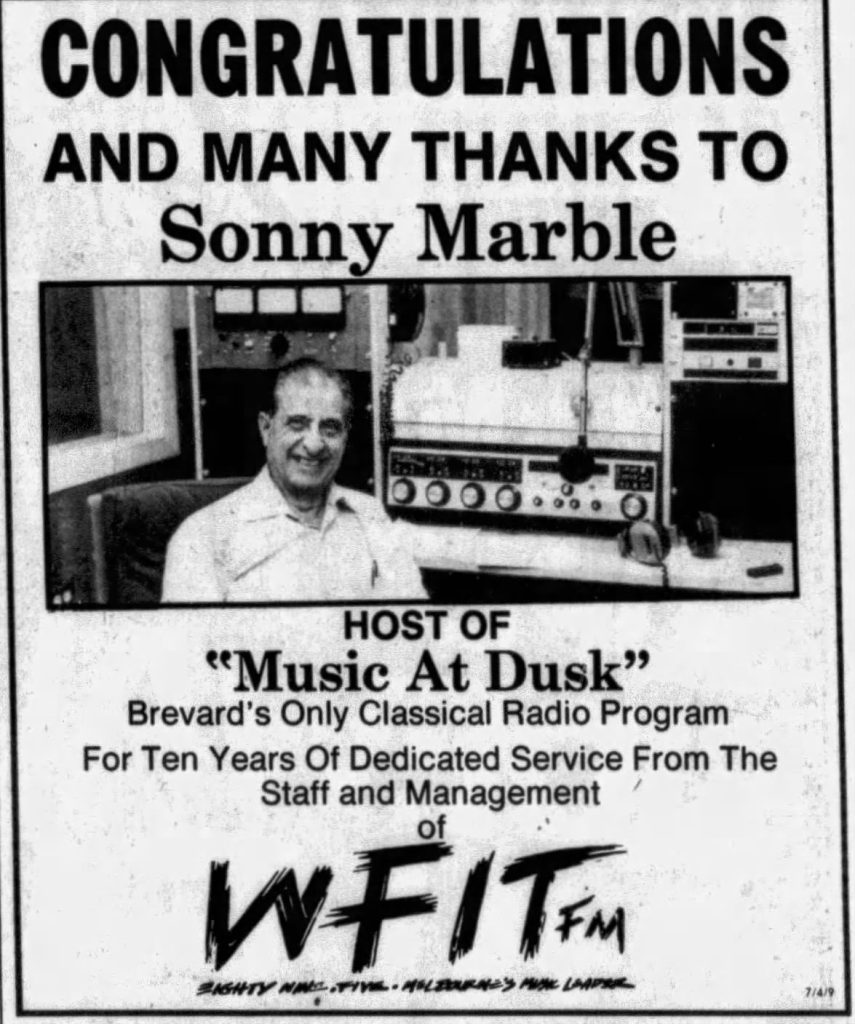
“The first three or four years,” Marble said, “it was hell. Many a time, I was at the brink of packing up my records and leaving the studio because of the calls and the kind of reception classical music was getting. … I consider these obscene phone calls.”
By 1985, when WFIT celebrated its 10th anniversary, Marble had become a fixture at the station.
“Everybody at the station really supports [Marble],” Florida Tech undergraduate John White said. “He’s probably the most respected person because he has been here from the beginning.”
Marble considered the students part of his family.
“They’re like my own kids. … I have a lot of respect for them. I love them all. They know that.”Bixler, B. (1985, July 4). “Spreading the gospel” of Classical Music. Florida Today.
WFIT was well on the way to becoming one of the most influential college radio stations by the decade’s close. Except for “Music at Dusk,” jazz and alternative rock dominated the programming. Florida Tech’s decision to slash its support for the station was a surprise.
“It was a university decision based on the assumption that WFIT was doing so well with fundraising that they could support themselves without Florida Tech’s financial help,” Fullerton said.
Jon Pernick ’85, ’87 M.S., the station’s general manager and a recent graduate, spoke for many when he said, “It destroyed the morale in the studio. … We’ve had to cut back on our spending or we’d be in trouble.”Florida Today Partners With WFIT. (2013, January 11). Florida Today.
No. 1 College Radio Station?
During the morale crisis, Pernick found a way to revive the students’ spirits.
The opportunity came in a conversation with a representative of I.R.S. Records, a subsidiary of the Universal Music Group, who suggested Pernick send WFIT’s playlist to “The Gavin Report.”
Begun in 1958, San Francisco-based “The Gavin Report” offered “tip sheets” for records that were “working” and “stiffing” on radio stations. The Report included a “College Countdown” for the country’s top college alternative stations. Getting a listing on The Report was not easy.
“I built up this whole package,” Pernick said. “I filled it with press clippings, T-shirts, mugs and all sorts of things.”
The editors were impressed. Overnight, WFIT began to receive record albums from the major record labels.Thompson, J. (1988, October 23). Spinning its Way to Big Time. Florida Today.
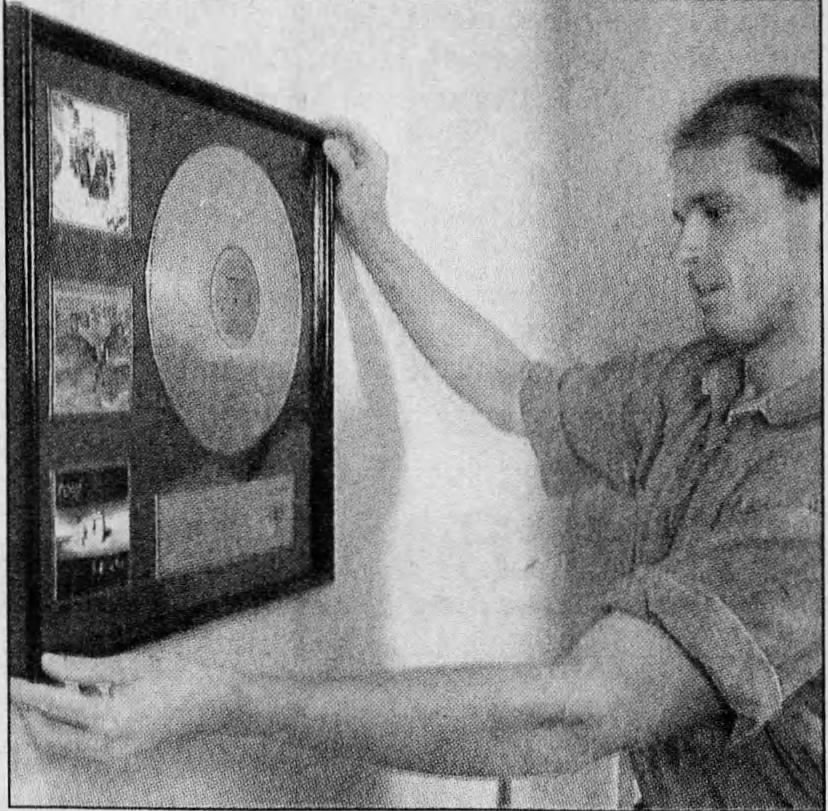
In 1989, the editors at “The Gavin Report” named WFIT and Pernick as finalists in the Annual Gavin Awards for Best College Radio Station and College Programmer of the Year.
“It’s an incredible honor,” Pernick said. “Everyone at the station is really excited. … We’re growing unbelievably fast.”Moore, C. (1989b, February 17). WFIT Vies for ‘College Station of the Year’ Honors. Florida Today.
KUSF, the University of San Francisco’s college station, edged WFIT out in the competition. Being finalists in the competition, however, won both the station and Pernick national attention. Billboard Magazine chose WFIT as one of the 10 colleges it surveyed for its alternative record chart.Thompson, J. (1988, October 23). Spinning its Way to Big Time. Florida Today.
The nomination meant new opportunities for Pernick. Six days after the San Francisco awards ceremony, Pernick resigned as WFIT’s station manager. He had accepted a position at SPIN Magazine in New York City. SPIN was founded in 1985 by Bob Guccione Jr. Guccione, whose father had launched the adult magazine Penthouse, hoped to create his own publishing empire. Guccione made Pernick responsible for organizing special events and marketing.Moore, C. (1989a). Spin Recruits WFIT Manager.
Changes
Jim Morrison and the Doors’ 1967 song, “The End” opens with the lyrics, “This is the end, beautiful friend, this is the end.”
Morrison, who was born in Melbourne, Florida, supposedly wrote the song after breaking up with his girlfriend. In 1990, though, the students and volunteers at WFIT received notice that “this was the end” of the student-run college station.
“I’m interested in building my own team,” said Rob Selkow, the nonstudent operational manager.
One of Selkow’s first acts was to fire Helen Urriola, the station’s longtime music director.
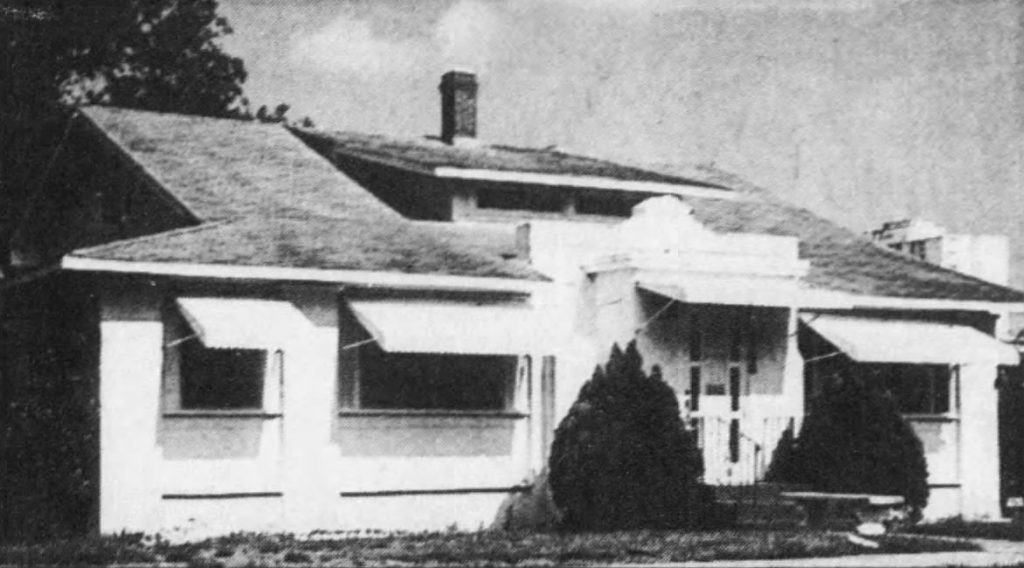
Keep the Freedom
A cascade of resignations followed.
“I’m not sure what’s going on,” Urriola said. “With no warning, I was simply dismissed.”
“It’s beyond logic,” said Gary Zajac, an eight-year volunteer. “Helen [Urriola] is one of the people who has built up WFIT not only in the eyes of the community but in the eyes of the music industry.”
“You’re going to make decisions and people aren’t going to like them,” Selkow responded. “That’s the way it’s always been.”Kennedy, P. (1990, November 29). WFIT Changes Put Volunteer Staff on Notice. Florida Today.
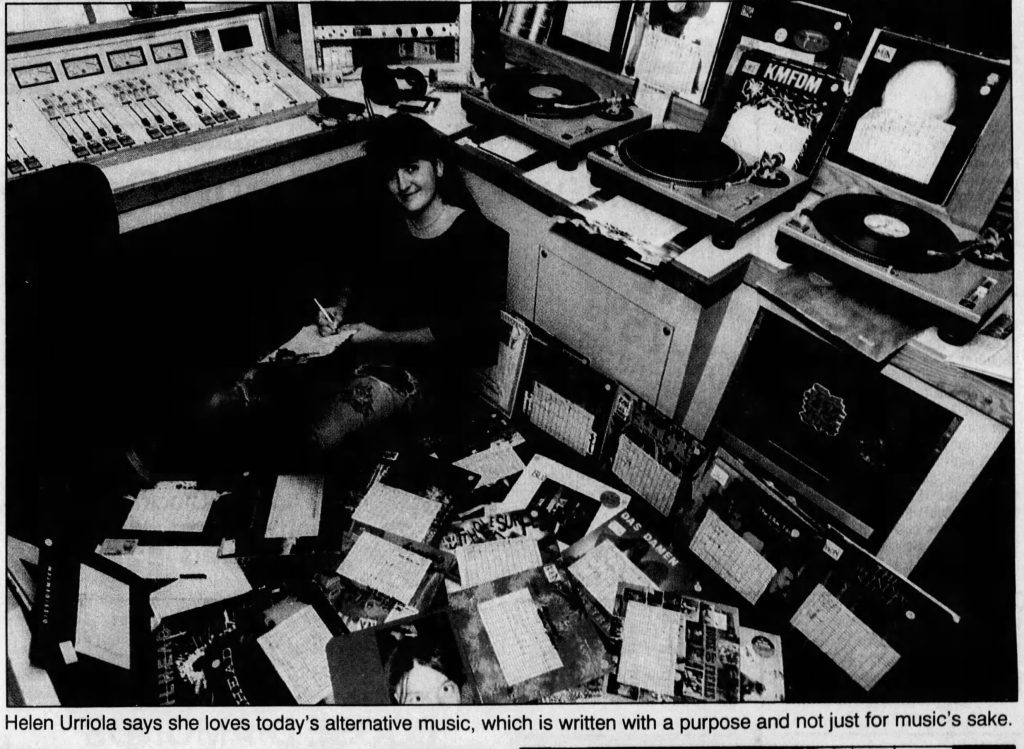
Over the next three years, students, volunteers and community members protested the changes. Calls for a return to WFIT’s “glory days” grew. Several of the DJs who had resigned organized a “Keep the Freedom” campaign. Dan Worth, a former DJ, filed a formal complaint with the FCC, alleging that Florida Tech’s administration had misappropriated government funds.
“It’s utterly untrue,” David Kershaw, Selkow’s boss and WFIT’s general manager, responded. “I have no idea what [Worth] is referring to.”Moore, C. (1993b, February 19). WFIt Radio Station Money Diverted to School, ex-disc Jockey Tells F.C.C. Florida Today.
Kershaw’s denial did little to dampen the Keep the Freedom movement. More than 100 people gathered at Melbourne’s Lazy Bean Coffee House to protest the changes at the station. Bumper stickers were distributed. T-shirts were sold to raise money for newspaper ads.Moore, C. (1993a, April 22). Deejay joins March. Florida Today.
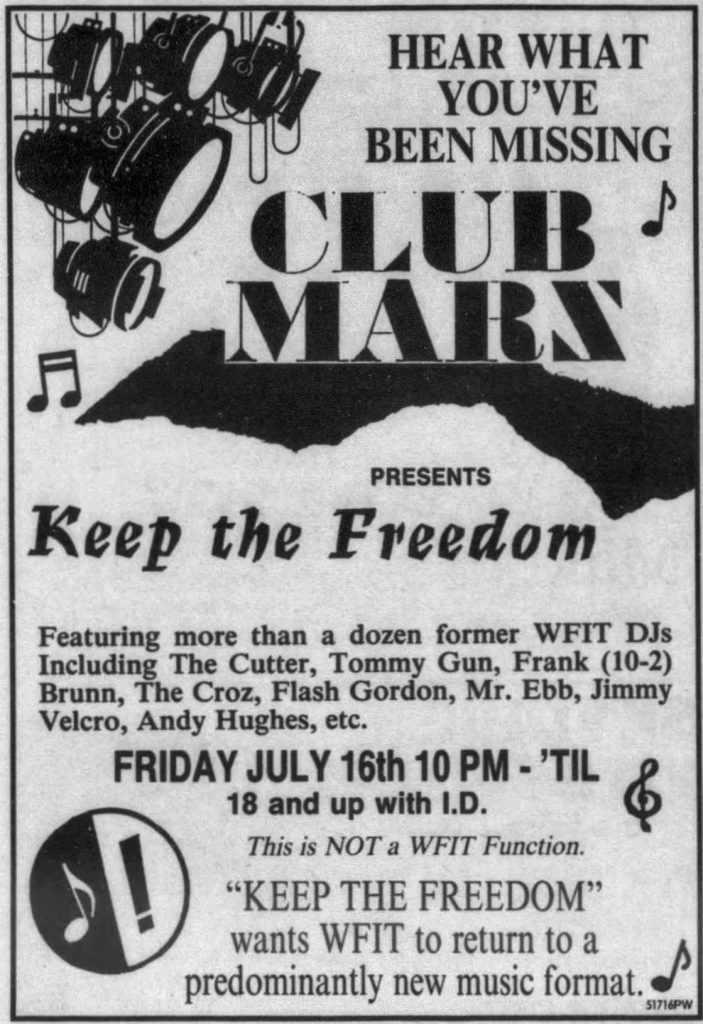
National Public Radio
Larger changes, however, were on the horizon. While the Lazy Bean’s baristas were serving coffee, Kershaw submitted a grant application to the Corporation for Public Broadcasting (CPC). In January 1994, he received word that the CPB had awarded WFIT a grant for $29,600.Florida Tech Broadcast Station Receives Grant. (1994, January 17). Florida Today. The money would be used to support new programming drawn from National Public Radio (NPR).
NPR programming was costly. This made it critical that the station demonstrated it had community support. Terri Wright, WFIT’s membership coordinator and a longtime runner, came up with a novel idea.
“I wanted something that would be a community event and get a lot of people involved,” Wright said. “Having a run seemed natural.”
Selkow and Brenda Harris helped organize the race. Instead of giving medals and ribbons, Wright came up with something different.
“We have the coolest trophies. They’re [CDs] with the running saxophone log silk-screened on them and mounted, then, on wood blocks.”Claywood, B. (1994, December 7). Saturday’s 5K Run to Benefit WFIT Radio. Florida Today.
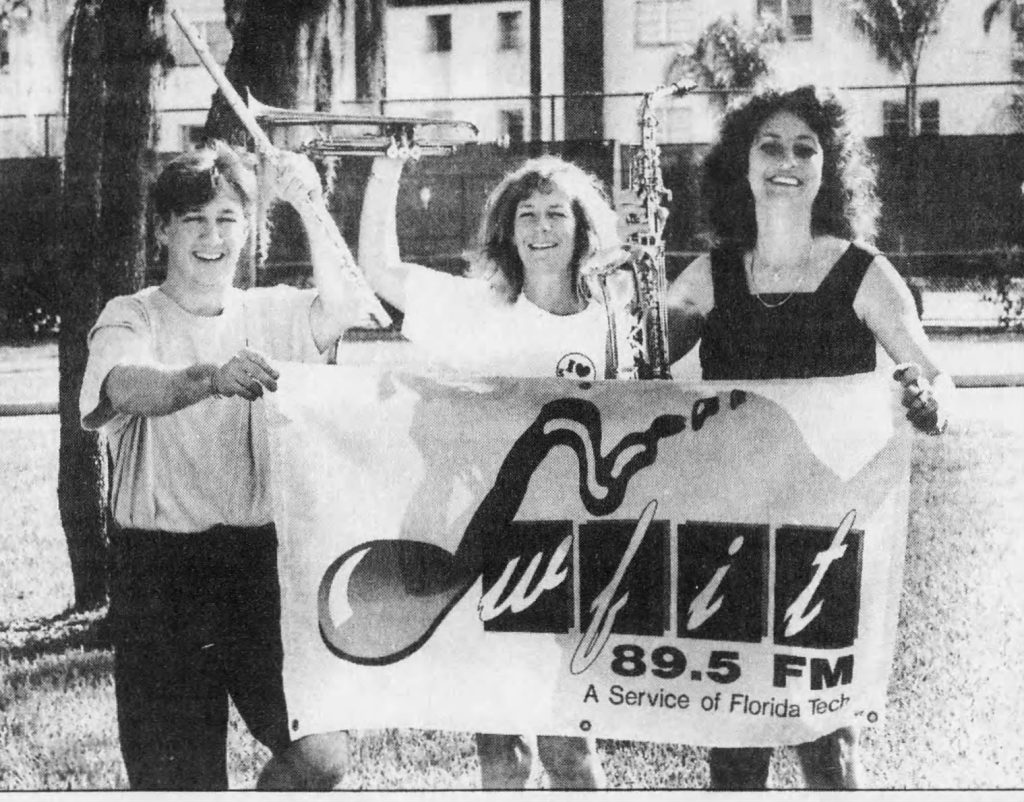
In 1995, WFIT became an NPR affiliate. The shift to NPR programming was a success. Kershaw announced that WFIT would add “Car Talk,” “E-Town,” “Morning Edition” and “All Things Considered.”
Other programs followed. WFIT made its foray producing programs for NPR in 1998. In 1991, the station had begun broadcasting Fred Migliore’s “An Unconventional Sunday Morning.” Seven years later, Migliore’s eclectic mix of folk and acoustic music, rechristened “F.M. Odyssey,” gained national syndication.
“F.M. Odyssey’s” syndication on 30 stations was only one of the major changes at WFIT that occurred in 1998. Wright was named the station’s general manager. Wright, who had led WFIT’s fundraising and membership initiatives since 1992, had a knack for building support. One of her first accomplishments came in October, when she secured permission to raise the station’s antenna 20 feet and increase the transmitter from 2.3 kilowatts to 4.6 kilowatts.
“We are expecting a 70 percent increased listener coverage,” Wright said. “We will be heard clearly in Sebastian and Vero Beach.”Hickman, B. (1998, October 7). WFIT Radio Station Gets a Power Boost. Florida Today.
A New Home and New Opportunities
Wright brought stability and professionalism to WFIT.
In 2003, Anthony Catanese became Florida Tech’s fourth president. Catanese, who had served as president of Florida Atlantic University, recognized WFIT’s importance. Local support for the station grew. Thad Altman, a member of the Florida Senate for District 16, which included Melbourne, made winning state support for WFIT a priority. Altman “proved instrumental in getting state funding for a [new] WFIT building.”
On October 11, 2012, Catanese presided over the building’s dedication. At the ceremony’s conclusion, TWITCHY, a musical group composed of Florida Tech faculty, presented the first live broadcast from WFIT’s new home.

Wright and Todd Kennedy, WFIT’s program manager, made the most of station’s new home. Its state-of-the-art recording studios opened a host of possibilities.
In 2014, Christian Tamburr, a celebrated vibraphonist and pianist, recorded the first of five albums at the station. Other artists followed. New programming was added. Andrew Walker, WFIT’s audio engineer, launched the ongoing series “Live in Studio,” which is archived on YouTube. In 2016, Wright and Kennedy began the annual Garage Band Contest.
Much has transpired since that Friday evening in 1975 when Charlie Brown began WFIT’s first broadcast on its 10-watt transmitter.
“A lot of people say radio is dying,” Kennedy observed with a smile.
That is not the case for WFIT. Nearly 30 community volunteers serve as DJs. Listenership continues to grow. The days of a student-run radio station have passed. WFIT, however, remains a vibrant force. In 2025, WFIT will celebrate its 50th anniversary.
The students and volunteers who made this station can be proud.




